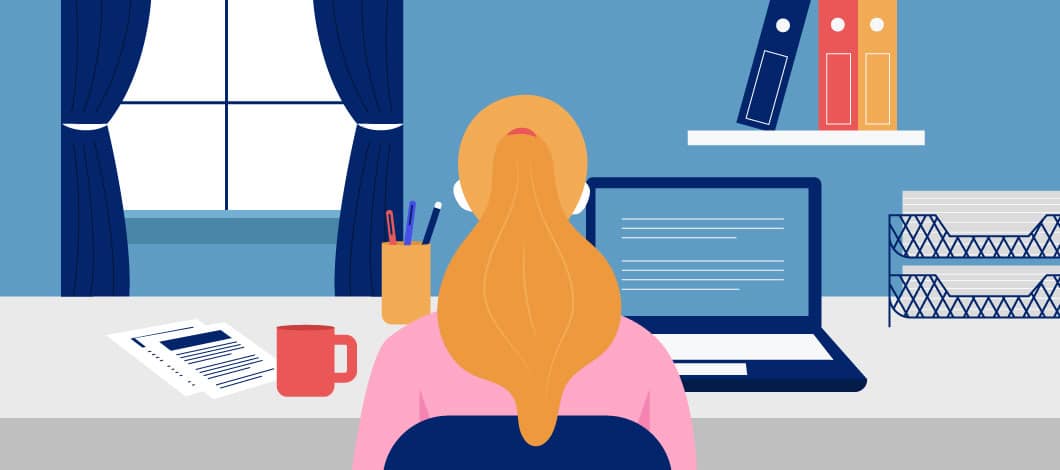The importance of work-life balance ranks highly for both business and personal reasons.
Here’s how to keep both halves in harmony:
- Set priorities
- Use a time-management system
- Get enough sleep
- Set aside time for breaks, weekends and vacations
- Stay fueled with good nutritional habits
- Incorporate exercise into your schedule
- Make child-care arrangements
- Consider flexible work arrangements
- Create a comfortable workspace
- Avoid unnecessary meetings
- Minimize digital time wasters
- Track business and personal finances separately
Learn more about what work-life balance means, why it’s important and how to balance work and life responsibilities.
What Is Work-Life Balance?
We can express a work-life balance definition in terms of time and stress management. When your work and life are balanced, you have enough time to manage both your personal and workplace responsibilities without getting overloaded and burnt out. In contrast, when your work and life aren’t balanced, you find yourself struggling to keep up and stressed out.
To illustrate with some work-life balance examples, a working mother who is able to arrange for daycare while she’s on the job will tend to experience less stress than a mother who’s trying to watch her kids and work at the same time. A business owner who sets aside time for relaxation on weekends will enjoy more balance than one who works 7 days a week for 12 hours a day.
These examples illustrate work-life balance as meaning a lifestyle that allows you to take care of both personal and work duties without getting overwhelmed. Expressed another way, achieving life and work balance means following a routine that meets your physical, emotional and social needs as well as your financial needs.
Why Achieving Work-Life Balance Is Important
There are many benefits to work-life balance for both your personal life and workplace performance. One of the most important is stress management. Trying to juggle work and personal lives is the third leading cause of stress in the workplace behind workload and people issues, according to a survey by employee assistance program provider ComPsych.
Balancing your work and personal lives can help alleviate both this stress source as well as related workload concerns.
Reducing stress by achieving a work-life balance can improve your health. Stress can promote a range of physical, emotional and behavioral problems, according to the Mayo Clinic. These can include headaches, tension, fatigue, sleep problems, anxiety and depression. Nearly one-third of Americans between ages 18 and 64 are seeing a doctor about something stress-related, according to a survey by health and wellness publisher Everyday Health.
Alleviating stress from an imbalanced lifestyle can improve your workplace performance. A study by insurance provider Colonial Life found that 41% of U.S. employees feel stress makes them less productive. Half say they lose 1 to 5 hours of work to stress on a weekly basis. Balancing your lifestyle can help you reclaim lost hours of productivity.
These are just a few ways that harmonizing your work and personal lives can benefit you. In general, improving your work-life balance tends to promote better physical, emotional, social and financial well-being.

How to Achieve Work-Life Balance: 12 Top Tips
Improving the integration between your work and personal lifestyle is a matter of optimizing key habits that affect both areas, such as goal setting, time management and financial planning.
There are many ways you can apply this general principle, but here are 12 of the most essential work-life balance tips:
1. Set Priorities
To harmonize your work with your personal life, it’s important to orient both of them around a set of common goals and priorities. Knowing what your priorities are can help you resolve conflicts between workplace and personal responsibilities based on what’s most important. This lets you rank items on your to-do list and organize your schedule accordingly.
To set your priorities, start by brainstorming a list of goals for your work and your personal life. Then rank them in order of importance. Focus on pursuing a few top goals at a time. Revisiting this exercise periodically will help you steer your work and personal activity towards your most important priorities.
2. Use a Time-Management System
To put your goal-setting strategy into effect, it helps to have a time management system. You can budget time the same way you budget money. Each day has 24 hours, and each week has 168. Scheduling your time in accordance with your priorities can help ensure that your most important items get done.
You can plan your schedule out in a notebook, in a spreadsheet or using a time-management app. Use whatever method works best for you.
3. Get Enough Sleep
Failing to get enough sleep can disrupt both your work and your personal life. This in turn can increase your stress level and hurt your productivity.
Sleep requirements vary by age and individual. As a general rule, adults between 18 and 64 should get 7 to 9 hours of sleep per night, according to the National Sleep Foundation.
4. Set Aside Time for Breaks, Weekends and Vacations
Like sleep, periodic breaks are important for refueling your body and relaxing your mind. Overwork can lead to increased stress and risk of burnout. Make sure that your time management schedule includes adequate time for breaks.
This should include:
- Periodic mini-breaks to stretch and rehydrate throughout the day
- Breaks for meals
- Relaxation time after work
- Weekend recreation
- Periodic vacations
- Hobbies
The amount of time you allocate for each category will vary with your situation, but each category is important.
5. Stay Fueled With Good Nutritional Habits
As with sleep and breaks, what you eat is vital for refueling your body for work and personal activities. The federal government has published dietary guidelines recommending best nutritional practices.
These include:
- Following age-appropriate eating habits throughout your lifespan
- Eating a variety of nutritious foods in all food groups in recommended amounts
- Limiting intake of added sugars, saturated fats and sodium
- Avoiding unhealthy foods and beverages
Adapt these general guidelines by following specific recommendations from your health professional or nutritionist.
6. Incorporate Exercise Into Your Schedule
A balanced lifestyle depends on exercise for good health and strength to perform daily tasks. The Centers for Disease Control and Prevention (CDC) has published physical activity guidelines for Americans.
Adults are advised to:
- Move more and sit less throughout the day
- Engage in 150 minutes of moderate to intense aerobic activity each week, spread out over multiple sessions
- Engage in muscle-strengthening activity at least twice a week
These are general minimum guidelines for all adults. A health professional or exercise coach can help you develop a routine suitable for your individual situation. Make sure to schedule sufficient time for exercise in your time management planning.
7. Make Child-Care Arrangements
Balancing work and family is one of the most important aspects of integrating workplace and personal routines. It also can be one of the most challenging if you have children or other family members to care for, such as elderly parents.
The coronavirus pandemic has added a dimension to this, forcing many parents to work from home while kids are home from school. If you’re in this type of situation, finding care for your children or other dependents can be a key to an effective work-life balance.
General resources for child care include:
- Care by spouses, relatives or neighbors
- Family child-care homes, hosted in residential buildings
- Child-care centers, operated out of commercial buildings
- Preschool programs
- School-age programs
If none of these are options for you and you have to take care of your kids while you work from home, you can apply your goal-setting and time management strategies to plan how child care will fit into your work schedule. Make a list of what needs to be done, which can include:
- Meal planning
- Exercise and play
- Chores
- Parents’ work hours
- Kids’ school work
Prioritize items on your list, and plan a schedule. Have a family meeting to discuss your plan so that everyone is aware of it.
8. Consider Flexible Work Arrangements
An increasing number of employers offer the option of working from home or choosing your own hours. Taking advantage of these types of flexible work arrangements may provide a way to arrange your schedule for better work-life balance.
Consider whether working from home or adjusting your work hours would help you better integrate your personal life and work responsibilities.
9. Create a Comfortable Workspace
An uncomfortable workspace can promote physical problems that affect both your work productivity and your personal health. If you’re experiencing discomfort in your workspace, consider doing an audit to identify potential issues, such as:
- Is your chair optimized for your desk?
- Is your computer screen at the right height for comfortable viewing?
- Is your screen set to the right display size for easy reading?
- Are your keyboard and mouse positioned for ergonomic use?
- Is your lighting sufficient?
- Are there any distracting noises that could be reduced or replaced with other sounds, such as soft music or white noise?
- Is the air quality good?
- Is the temperature set comfortably?
Depending on whether you work from home or in an office, you may have more or less control over some of these issues. Adjust what you can to make your workspace more comfortable.
10. Avoid Unnecessary Meetings
Meetings represent one of the biggest time management challenges in the workplace, which can cut into both work and personal schedules. Executives spend an average of 23 hours a week in meetings, according to research published in the Harvard Business Review. A survey of senior managers found that 65% say meetings keep them from getting their work done, and 71% consider meetings inefficient and unproductive.
To reduce time spent at meetings, avoid meeting to discuss issues which could be handled more efficiently another way. For example, a topic that could be handled by 3 key personnel communicating through the company intranet does not necessarily require the entire department to convene. When you must have a meeting, go in with a clear agenda and stay on topic.
11. Minimize Digital Time Wasters
Email, web browsing and social media can become major time-management issues, both in personal life and in the workplace. For example, an Adobe survey found consumers spend an average of 2.5 hours a weekday checking personal email plus another 3.1 hours a day checking work email.
Minimize the amount of time you spend on digital media by scheduling specific, limited blocks of time to check communications channels. Unsubscribe from email lists you don’t need. Put your phone on silent when you’re focused on something else. If you receive push notifications, adjust your settings to moderate their frequency. In some situations, you may wish to consider delegating or outsourcing management of your social media accounts or email.
12. Track Business and Personal Finances Separately
Mixing business and personal finances can disrupt the financial aspect of your work-life balance. Many small business owners use their company accounts to pay for personal expenses without carefully tracking payments. This can create bookkeeping problems, make it difficult to track tax deductions and potentially hurt your company cash flow or personal finances.
Avoid these problems by tracking your business and personal finances separately. Keep separate bank and credit card accounts for business and personal use. Use separate accounting files to track business and personal finances, or make personal transactions a distinct line item that can be easily segregated.
Balance Your Work and Life for a Better Experience of Both
Striking a balance between your work and personal habits can help you enjoy a less stressful lifestyle which improves your health and social relationships as well as your workplace productivity.
Follow the tips in this article to adjust the balance between your work and personal responsibilities for a better integration of both.











